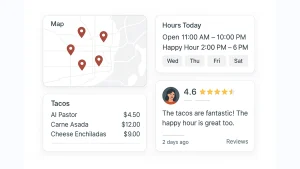Running SEO for a single restaurant is like plating a dish for a VIP table. Running SEO for a restaurant group is a whole banquet—multiple kitchens, different menus, varied hours, and customers searching in dozens of neighborhoods at once. The job is to orchestrate all of that without letting locations compete with (or cannibalize) each other.
This guide gives you a practical, technical roadmap to scale organic traffic and reservations across many sites and cities. You’ll get structure, schema, internal linking, Google Business Profile (GBP) strategy, NAP governance, anti-cannibalization tactics, and real-world mini cases you can use today.
Why Restaurant Group SEO Is Its Own Sport
Most local SEO advice is written for single locations. Groups face extra complexity:
-
Searcher intent fragments by neighborhood. “Best tacos” becomes “best tacos Downtown,” “Seminole Heights happy hour,” or “near me.”
-
Duplicate content traps. Copy-paste “About,” menus, and promos trigger cannibalization and thin content problems.
-
Platform sprawl. You’ll juggle POS pages (Toast, SpotOn), marketplaces (DoorDash, Uber Eats), and web builders (WordPress, Squarespace, Wix) while keeping one source of truth.
-
Brand vs. location signals. Google must understand Brand X and Brand X – Southside as separate entities with shared lineage.
The solution is governance plus repeatable templates, enforced through your CMS and listings stack.
Information Architecture: Choose the Right Home for Each Location
Your site structure is the backbone of your SEO. Pick one pattern and commit:
Recommended (most groups):brand.com/locations/ as the hub, then one page per location:
brand.com/locations/
brand.com/locations/city-neighborhood/
brand.com/locations/city-neighborhood/menu/
brand.com/locations/city-neighborhood/happy-hour/
brand.com/locations/city-neighborhood/catering/
Why this works: clear hierarchy, shared templates, controllable internal links, easy to scale structured data.
When to consider subdomains: only for distinct brands inside the holding company:seafood.brand.com, taqueria.brand.com. Avoid subdomains for locations; they dilute authority.
Avoid: separate microsites for each location unless there are radically different brands, teams, and marketing calendars. Microsites multiply cost, fragment authority, and invite cannibalization.
Navigation:
-
Global “Locations” nav item linking to
/locations/. -
On every brand page, a nearest location module (auto-detected or ZIP search).
-
Breadcrumbs: Home → Locations → City → [Neighborhood].
NAP Governance: One Source of Truth or Chaos Ensues
NAP = Name, Address, Phone. In multi-location SEO, consistency is a ranking factor and a customer-experience lifeline.
-
Maintain a central NAP registry (Airtable/Sheet + API or CMS fields). Include hours, holiday hours, parking notes, and delivery partners per location.
-
Enforce exact formatting across site, GBP, Facebook, Instagram, Apple Maps, Bing, Yelp, OpenTable/Resy, and delivery platforms.
-
Use a unique local phone number for each location (and for call tracking, use number insertion on the website only—don’t change the hard NAP number in GBP).
-
Push NAP updates to aggregators (Data Axle, Neustar/Localeze, Foursquare) and major maps. Quarterly audits reduce drift.
Pro tip: Put an “Updated on: YYYY-MM-DD” field on each location page. Freshness helps trust and operations.
Google Business Profile for Groups: One Brand, Many Doors
Each location gets its own GBP listing with consistent brand naming:
-
Name:
Brand Name – Neighborhood(not keyword-stuffed). -
Primary category: match the actual cuisine/format (e.g., Mexican restaurant).
-
Attributes: dine-in/takeout/delivery, happy hour, outdoor seating, accessibility.
-
Menu and Order links: deep-link to the location’s menu and location-specific online ordering or reservation URL. Use UTM tags to distinguish channels.
-
Photos & Videos: minimum monthly cadence per location (exterior, interior, hero dish, staff).
-
Posts: promos, seasonal menus, and events pushed to each listing (not just HQ).
-
Q&A & Reviews: reply from a location voice. Pin FAQs in Q&A (parking, brunch hours, reservations policy).
-
Service area: for delivery concepts, define realistic polygons, not entire counties.
Multi-brand groups: create an Organization profile linking to brand/location knowledge panels via your website’s Organization schema (see below).
Location Pages That Actually Rank (and Convert)
Every location page should be a conversion powerhouse with unique local cues:
-
Hero block: Name, cuisine shortline, primary CTA (Reserve/Order), hours today, phone, address with embedded map, and a “Directions” button.
-
Local story: 120–200 words describing this location—block landmarks, neighborhood vibe, chef/GM, signature dishes, patio/dog-friendly notes.
-
Menu section: Rendered as HTML, not just PDFs. Include a downloadable PDF for users, but don’t rely on it for SEO.
-
Promos: Happy hour, brunch, seasonal dishes. If group-wide, give each location a local spin (time, photo, staff quote).
-
Photo gallery: real photography from this venue. Alt text uses neighborhood and dish references sparingly.
-
Social proof: review snippets and ratings from GBP/Resy/OpenTable (with permission), plus recent customer photos.
-
Accessibility & logistics: parking, kid-friendly, group bookings, private dining capacities, patio rules.
-
FAQ: answer booking policies, waitlist, allergens, birthday desserts, corkage—these are high-intent long-tails.
-
Local internal links: link out to nearby neighborhood guides and brand pillars (catering, gift cards).
-
Technical: fast, mobile-first, Core Web Vitals green, no heavy carousels. Cache menus and compress images (<100 KB where possible).
URL pattern:/locations/city-neighborhood/
Title tag: Brand – Cuisine in Neighborhood, City | Reservations & Menu
H1: Brand – Neighborhood, City
Schema: Mark Up the Truth
Use JSON-LD on every location page.
-
LocalBusiness (or subtype:
Restaurant,Bakery,BarOrPub): name, address, geo, telephone, openingHours,servesCuisine,priceRange,acceptsReservations. -
Menu: either embed
hasMenuwith a URL to your HTML menu page or includeMenu/MenuSection/MenuItemmarkup inline. -
FAQPage: for the on-page FAQs.
-
Organization: at the root domain with
brandproperties pointing to your brands,sameAslinking to official social profiles. -
BreadcrumbList: match visible breadcrumbs.
For reservations: add potentialAction with ReserveAction pointing to OpenTable/Resy or your native booking URL.
For multiple languages (e.g., English/Spanish): implement hreflang and ensure menu items are truly translated, not duplicated.
Cannibalization: Diagnose and Fix the “Who Ranks Where” Problem
Symptoms: multiple pages from your domain competing for “best brunch CITY,” or the brand home outranking the location page for “Brand + Neighborhood.”
Causes:
-
Duplicate or near-duplicate location pages with minimal unique content.
-
A generic “/menu/” page competing with “/locations/city/menu/”.
-
Internal links pointing to the wrong page (e.g., all “menu” buttons go to HQ).
-
Blog posts optimized for the same generic terms as the location pages.
Treatments:
-
Keyword mapping by page type. Reserve generic head terms for the brand home; long-tails and geo-modifiers for locations.
-
Internal linking rules: all “Menu” CTAs from a location must link to that location’s menu. Sitewide nav can keep a global menu link, but add a smart switcher that suggests the nearest location’s menu.
-
Canonicalization: location pages should be self-canonical; avoid pointing canonical to generic pages.
-
Unique content quota: require at least 250–400 unique words per location (not counting shared blocks), plus unique photos and reviews.
-
Noindex generic rollup pages that exist only for UX (e.g., filterable search results for “brunch”).
-
Siloing:
-
Brand pillar:
/brunch/(educational + brand position). -
Location implementations:
/locations/city-neighborhood/brunch/(time, specials, photos, local proof). -
Cross-link down (pillar → locations) and laterally between nearby neighborhoods sparingly to avoid loops.
-
Menus That Rank (and Sell)
Menus are your money pages. Treat them like product catalogs:
-
HTML first with headings per section (H2: Tacos, H2: Mains; H3 per item if long).
-
Schema
Menu/MenuItemwithdescriptionandoffers(price). -
Daily items (e.g., lunch specials) can be stored as CMS fields with time-based visibility; keep URLs stable.
-
Images: a few high-quality dish photos beat bloated galleries. Add alt text that describes the dish (not keyword stuffing).
-
PDF menus: keep a lightweight PDF for downloads, but do not rely on it for discovery. If you must use PDFs, link the HTML page first, then the PDF.
-
POS/ordering: when you embed Toast/ChowNow/Flipdish, wrap with crawlable context (section intros, FAQs, bestsellers) so the page has indexable content beyond the iframe.
Reviews, UGC, and Local Links at Scale
-
Build a review pipeline per location: post-visit SMS/email → choose platform (GBP default) → segment Detractors for direct service recovery.
-
Feature location-specific review excerpts on the page with proper markup (avoid adding aggregate rating schema unless you can maintain compliance).
-
Earn local links: chambers of commerce, neighborhood associations, farmers’ markets, local media, charity events, food festivals. Each location should have its own small link budget and outreach list.
-
Encourage UGC with a simple hashtag, then request permission and attribute. Fresh photos = freshness signals + conversion lift.
Multi-Location GBP Reporting & Tagging
-
Append UTM to each GBP link:
?utm_source=google&utm_medium=organic&utm_campaign=gbp&utm_content=city-neighborhood -
Track Reservations/Orders as GA4 events with location dimension (URL path, UTM content, or custom parameter).
-
In Search Console, create a domain property plus URL-prefix properties for key subfolders (
/locations/). -
Analyze GBP impressions vs. website clicks by location to identify underperformers (often missing photos, weak categories, or NAP inconsistencies).
Technical SEO: Keep the Engine Fast and Clean
-
Core Web Vitals: aim for LCP <2.5s, INP <200ms, CLS <0.1 on location pages and menus.
-
Image discipline: WebP/AVIF where supported, <100 KB hero variants for mobile, width/height attributes set.
-
Sitemaps: include
/locations/and their major child pages; update on publish. -
Robots/indexing: block POS parameter soup (
?locationId=,?category=) with patterns if they create duplicates; allow clean, canonical HTML pages. -
Internationalization: if you serve tourists, consider ES translations for top locations, with
hreflangand dedicated/es/locations/.../. -
Accessibility: semantic menus, keyboard nav, color contrast, alt text—this also improves SEO and conversions.
Mini Case Snapshots (Anonymized)
Case A: Urban brunch group (8 locations)
Problem: brand homepage outranked locations for “best brunch + city.”
Fix: unique 300–500 word local stories, brunch subpages per location, internal links from /brunch/ pillar to each location.
Outcome (90 days): +62% organic clicks to location pages, +37% reservation starts; GBP calls up 24%.
Case B: Regional taquería (12 locations)
Problem: PDF-only menus and POS iframes; thin pages.
Fix: HTML menus with MenuItem schema, dish photos, FAQ on allergens, and local parking notes.
Outcome (120 days): +83% menu page impressions, +29% organic online orders; “tacos near me” queries started landing on the nearest location page.
Case C: Mixed brands under one parent (3 brands, 15 locations)
Problem: inconsistent NAP and duplicate “happy hour” content.
Fix: centralized NAP registry, standardized GBP naming, per-location happy hour subpages, canonical cleanup.
Outcome (180 days): +51% discovery searches in GBP, 18% reduction in cannibalized queries (measured by GSC overlapping URLs), and smoother operations.
90-Day Launch Plan (Repeatable)
Days 1–10: Audit & Map
-
Inventory all locations, GBPs, NAP, menus, and delivery links.
-
Map keywords to page types; identify cannibalization clusters in GSC.
-
Decide IA and URL patterns.
Days 11–30: Build the Template
-
Create the location page template with schema, FAQs, and modules.
-
Stand up HTML menu template with
MenuItemschema. -
Implement breadcrumbs, internal link rules, and UTM conventions.
Days 31–60: Rollout & GBP
-
Publish/refresh top 5 priority locations.
-
Align GBP for those locations: photos, categories, menu/reservation deep links with UTM, and first Q&A batch.
-
Start local link & review campaigns.
Days 61–90: Scale & Tune
-
Roll out remaining locations.
-
Fix cannibalization via content and internal links.
-
Hit Core Web Vitals targets and compress images.
-
Report by location: impressions, clicks, CTR, reservations/orders, phone calls.
Common Pitfalls (and Quick Fixes)
-
All menus live at
/menu/→ Duplicate intent. Fix: move to/locations/city/menu/and keep/menu/as a brand pillar with links down. -
Stock photos across all locations → Low trust. Fix: shoot 10 photos per location; recycle across GBP and site.
-
One phone number for all stores → Tracking nightmare. Fix: unique local numbers; dynamic number insertion for ads only.
-
Iframe-only ordering pages → No indexable content. Fix: wrap with text, FAQs, and internal links.
-
Keyword-stuffed GBP names → Risky. Fix: brand + neighborhood—clean and compliant.
Content Beyond the Menu: Local Depth Wins
Location pages rank best when supported by geo-specific content:
-
Neighborhood landing pages: “Dining near [Arena/University/Beach]” referencing your location as a hero option.
-
Event content: “Pre-game happy hour,” “Theatre night dinner,” with internal links to reservations.
-
Catering & group dining: capacities, sample menus, floor plans, inquiry forms—often high-margin pages.
-
Job pages per location: discoverable by city; they earn links and brand searches.
Tie these to your email and social calendar so local buzz shows up in Google, not just Instagram.
Governance: The Boring Stuff That Wins
-
CMS fields, not free text. Lock NAP, hours, and core CTAs into structured fields so editors can’t break consistency.
-
Editorial checklist for each publish: NAP verified, schema validated, internal links tested, images compressed, GBP links UTM-tagged.
-
Quarterly audits: GSC cannibalization review, GBP category/attribute refresh, citation sweeps, Core Web Vitals check.
-
Training: teach managers to post to GBP and collect reviews. The best SEO lever is a trained local team.
The KPI Stack That Matters
-
By location: Organic sessions, reservations/online orders, phone calls, direction requests, and GBP clicks.
-
By query class: “near me,” “city + cuisine,” “happy hour,” “brunch,” “catering.”
-
By page type: Location, location menu, catering, private dining, brand pillars.
-
Quality: LCP/INP/CLS, index coverage, schema errors, duplicate title/H1 conflicts.
-
Ops signals: review velocity, response rate, photo freshness.
From Breadcrumbs to Bookings: Make Every Location a Landing Page
Restaurant group SEO isn’t about tricking algorithms; it’s about clarity. Tell Google—and your guests—exactly which door to walk through. Pick a clean architecture, enforce NAP truth, give every location a rich, useful page, and wire GBP to the right URLs with UTM discipline.
Add unique photos, real FAQs, and menu pages that behave like product pages. Solve cannibalization with content, canonicalization, and common sense.
Do this consistently, and every search becomes a short path to a seat, a plate, and a repeat visit.









